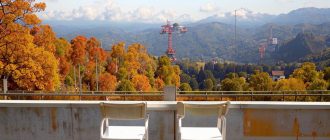The World Cup is the most favorite and long-awaited event of all fans. For 93 years of the tournament’s existence, it has been hosted by dozens of countries from completely different parts of the world. The organizers tried to surprise players and guests with unusual architecture of arenas. They succeeded. Collected nine of the most beautiful objects, which have long become a national attraction of the states.
“Centenario” – World Cup 1930.
City: Montevideo (Uruguay)
Year of opening: 1930
Capacity: 60,235
The stadium that hosted the first World Cup in history. The name means “century” in translation. It was not chosen by chance, but was timed to coincide with the centenary of the country’s independence.
In 1983, FIFA officially named it a “historic monument of world soccer”. Which is unique, because no other stadium has ever been honored with such a status. Today there is powerful lighting, new turf, bleachers and seats. On the territory of “Centenario” built two masts, which are turned on every night and illuminate the Batlle Park.
“San Siro” – World Cup-1934 and 1990
City: Milan (Italy)
Year of opening: 1926
Capacity: 75,817
The bowl’s second name is Giuseppe Meazza, in honor of the legendary Italian player. The most famous of stadiums in the history of soccer. Why. The arena hosted two world championships at once – in 1934 and 1990. “San Siro” on the perimeter surrounds 11 towers. Their task is to support the upper tier of stands and the roof.
The style of construction refers us to the direction of architecture of 1930-1960s: modernism and functionalism were popular then. That is why they decided to abandon ethnic features in the design. But this did not spoil the appearance, but, on the contrary, made it stand out among the rest. The use of concrete in the design refers the stadium to the Brutalism style.
“Orange Velodrome – 1938 and 1998 World Cup.
City: Marseille (France)
Year of opening: 1937
Capacity: 67,000
The facility is considered one of the grandest and greatest structures in the country. Tourists visit it on par with the Eiffel Tower and the Louvre. “Orange Velodrome” is located near the historical center of Marseille. Now it is the home stadium of the local “Olympique”. The World Cup was held here, and twice – in 1938 and 1998. Therefore, it is considered the most favorite stadium of fans.
The name of the arena is due to the fact that before there were running and bicycle tracks here. However, now they are gone, but the name has been preserved. “Velodrome” was often reconstructed. Now its roof covering is made of 5500 tons of metal, which is 80% of the Eiffel Tower. Moreover, the arena is the most gigantic in the country.
“San Nicola” – WORLD CUP 1990
City: Bari (Italy)
Year of opening: 1990
Capacity: 58,270
The stadium is second to the San Siro in fame, but not in beauty and architecture. From the outside, the bowl looks very much like a giant flying saucer. But if you look from the inside, it looks like a flower. Indeed, the stands consist of 26 “petals”, each of which is separated by space. This is due to the safety of fans. In the 90’s it became the first stadium with technological lighting, which allowed to play evening matches without shadows on the soccer field. Nowadays nobody can be surprised by such a thing, but at that time it was a real revolution!
The name of the arena was chosen by Italian citizens. A vote was held, in which 115 thousand people took part. 37% voted for “San Nicola”, because he is the patron saint of Bari. Other options: “Stadio Mediterraneos” and “Stadio Adzurro”.

“San Nicola”
“Allianz Arena – 2006 World Cup.
City: Munich (Germany)
Year of opening: 2005
Capacity: 75,024
The stadium is located in the center of Munich. The soccer club Bayern Munich plays here. The shape of the bowl resembles an inflatable boat or air cushion. The facade of the facility actually consists of 2,760 diamond-shaped air chambers. They are made of the thinnest layer of ethylfluoroethylene.
The body of the structure is backlit in red, white or blue. Remarkably, each is illuminated separately. The shades are a reference to the colors of German teams that played here at different times. We are talking about Bayern, the German national team and Munich-1860. The glowing roof can be seen even from the Alpine Mountains. And they are located 70 kilometers from the city!
“Arena da Amazonia” – World Cup 2014
City: Manaus (Brazil)
Year of opening: 2014
Capacity: 44,300
The stadium is located in the city of Manaus, surrounded by a tropical massif. The area is located 1500 km from the coast, here the Rio Negro flows into the Amazon. The design of the bowl resembles a bird’s nest. The forms of the object are a reference to the motifs of Brazilian flora. The covering is divided into large quadrangles with rounded corners, resembling huge leaves of tropical plants. The roof of the stadium consists of metal beams with cross sections. They protect from seasonal rains. The facade is made of translucent fiberglass fabric, which does not let the sun’s rays through.
The environmental factor was important in the construction of the arena. Thus, they organized the collection of rainwater for flushing toilets and watering the lawn, and the energy supply was provided by solar panels. “Arena da Amazonia” has LEED green building certification.
“Arena das Dunas” – World Cup 2014.
City: Natal (Brazil)
Year of opening: 2014
Capacity: 31,375
The host country of the 2014 FIFA World Cup has prepared quite well for the important world event, so two of its stadiums have made it into our selection. Natal is the easternmost point of the state. This area is called the “city of the sun”. The name of the bowl translates to “dune arena”. To this was the reference in the design of the facility, the stadium represents the white sand dunes of the city. The shape of the roof resembles a flower. Inside the complex there is an artificial reservoir, a shopping center, a hotel and offices. The stadium was highly appreciated by FIFA.
“Luzhniki” – World Cup 2018
City: Moscow (Russia)
Year of opening: 1956
Capacity: 78,011
The selection of beautiful stadiums of the world included the main arena of the USSR and Russia. Before the championship, a global reconstruction was carried out here. The running tracks disappeared, the angle of the stands was changed. But they decided to preserve the facade as an icon of national sports.
The colonnade, which encircles the entire stadium, continues to decorate its image. Only the frieze was renewed, the images of symbols of different sports were put on a wide metal band. A street with a cascading staircase appeared behind the historic wall.
“El-Bayt” – World Cup 2022.
City: El-Haur (Qatar)
Year of opening: 2021
Capacity: 68,895
Despite its inconvenient location – it’s located 35 kilometers from Doha – it’s hard to beat in terms of beauty. The facility resembles a tent, an age-old symbol of the region’s nomadic peoples. The inside of the bowl is no less beautiful: you get the impression that you are entering a Bedouin tent. This is not only a tribute to tradition, but also protection from the exhausting heat. There is a sliding roof for good weather. Soccer is not so developed in the country, so the bowl will soon be transformed into a shopping center.






